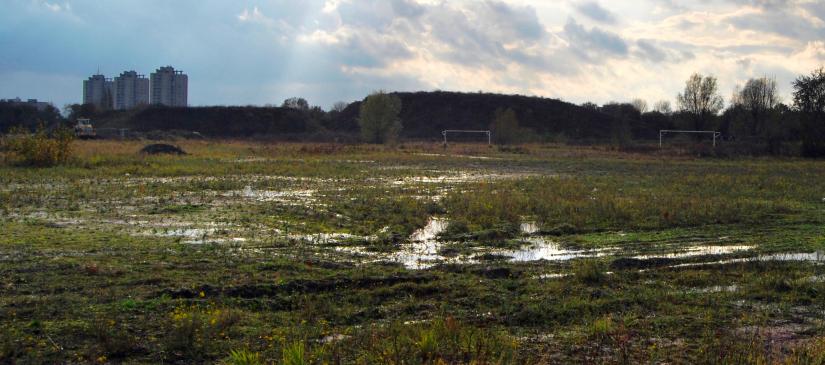This article was originally published in The Conversation. Read the original article.
Sport is seen as a key part of Australia’s identity. Yet woefully rundown facilities and outdated sport offerings are creating significant barriers to youth participation.
In partnership with the Cooks River Sporting Alliance, Canterbury Hurlstone Park RSL Club, and 12 public and private schools from Sydney’s inner west, we’ll be working with youth to co-design an innovative program to reverse the decline in youth participation in sport.
Our program, Designing in Youth, will feature new sport offerings, advertising materials and redesigned facilities.
Research shows that environmental design works best when it considers multiple factors. Thus, the first phase of our project is a survey to identify psychological and social barriers alongside environmental drivers of youth sport participation.

Neglected and sub-par facilities are one of many barriers to youth participation in sport.
Barriers to participation
Australia’s sporting landscape offers more barriers than motivations for youth, and the effects are obvious. The World Health Organisation recommends 60 minutes of physical activity every day. In Australia, only one in ten young adults do this.
Despite many programs to increase youth physical activity and sport participation, results have been inconsistent. Perhaps these programs’ failure to have a lasting impact on young people’s exercise habits is due to their highly structured nature and lack of youth leadership.
Youth report their reasons for playing sport include enjoyment, development of physical and motor skills, self-esteem and peer interaction, among other factors. We hypothesise that better interventions emphasise the fun factor and involve peer-led, unstructured play. This should produce long-lasting improvements in attitudes to physical activity.
Most organised sports promote practice and winning over play, are primarily coach-led and do not encourage the development of physical and motor skills. These factors are barriers to youth sport participation.
This is partly due to poorly designed facilities. Few facilities promote both social and competitive participation, focus on peer leadership, or offer a wide variety of sporting activities in one place.
Neglect of grassroots sport
In New South Wales, the divide between elite and grassroots sport is huge. Most youth participation is in grassroots sport, but the funding mostly goes into elite clubs.
Sports fields for grassroots clubs are commonly placed as afterthoughts, typically on leftover land. In NSW, this can be seen along Cooks River in the suburbs of Hurlstone Park and Canterbury. Here, sporting events and practices are regularly cancelled due to flooding.
To make things worse, many fields are not designed for sport and poorly maintained. The uneven, pitted surfaces are bad for play.
At these fields, bathroom blocks are rare, dirty and often falling apart. There are usually no changing rooms or showers. Many fields have few, if any, benches to sit on, and no access to food and drink vendors.
In addition, facilities are usually designed for one sport only. This leaves parents or siblings with nothing else to do while they wait.
In other countries, such as the Netherlands, facilities for local sport clubs function as community centres. Their fields are designed for various sporting activities and have playgrounds and hospitality centres nearby.
Why does participation matter?
The decline in sport participation may be a factor in the rise of poor mental health. Despite decreases in substance abuse such as smoking and binge drinking, rates of self-harm, depression, anxiety and suicide are on the rise among Australian youth.
Many studies have found habitual sport activities are an effective way to improve mental health. Other health benefits include reductions in obesity and blood pressure. The 2010 report, Australian Sport: Pathway to Success, recognised boosting youth participation in sport and supporting grassroots clubs as important for improving both population health and national sporting success.
Despite all this evidence of many benefits, studies have charted a steady global decline in sport participation between the ages of 11 and 16. Participation is particularly low among older girls.
Past studies have identified some barriers to participation. These include reduced parental influence on choice of activity, boredom with the available sports, and time challenges created by increased academic workload.
Other possible barriers such as poorly designed and maintained public parks have not been well studied. It’s probable that the poor condition of facilities and the lack of variety in sports and other non-sporting amenities on offer also discourage participation.
A new approach to involving youth
If we’re to increase youth participation, we need to include their opinions in the redesign process to ensure being involved in sport appeals to them.
Most programs worldwide have focused only on promoting an overall increase in physical activity. But regular and vigorous sports participation has greater long-term benefits, including improvements in children’s learning.
We hope Designing in Youth will help create a whole new landscape for sport in Sydney’s inner west. If successful, our communities and our use of public outdoor space will change for the better.
We should see youth outside again. And maybe, just maybe, we will restore our status as a sporting nation.
This article was originally published in The Conversation. Read the original article.
Byline: Deborah Ascher Barnstone: Professor, Associate Head of School, School of Architecture, University of Technology Sydney. Fiona Brooks: Professor of Public Health, Associate Dean Research, University of Technology Sydney . Job Fransen: Lecturer in Skill Acquisition and Motor Control, University of Technology Sydney. Originally published in The Conversation.

